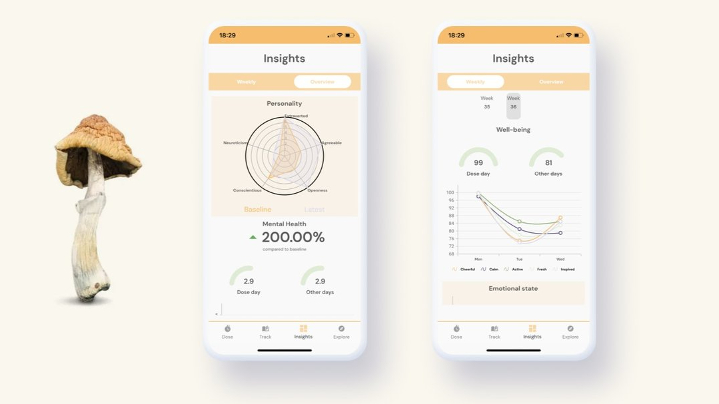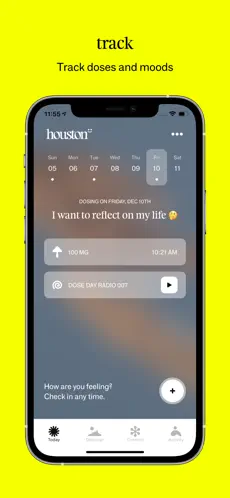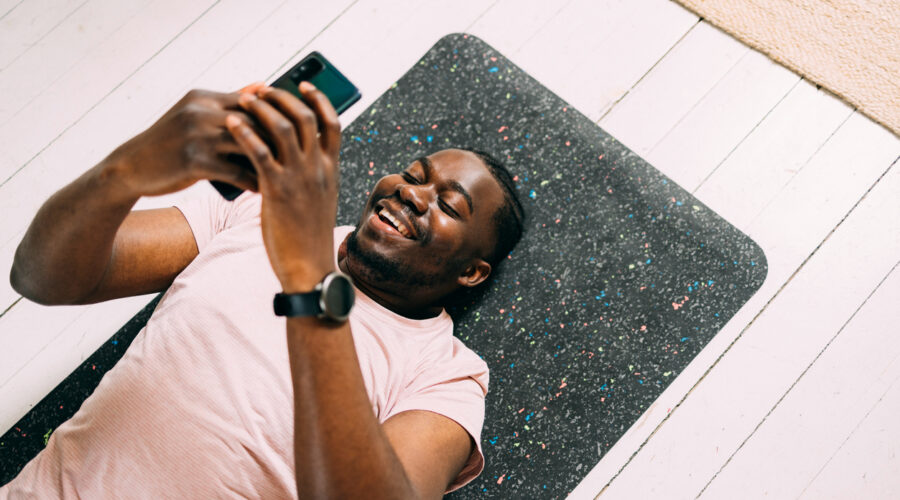Microdosing Apps Analyze Your Sub-Perceptual Trip
Are you doing non-psychedelic psychedelics? A dose so low you don’t know if you dosed yourself? A sliver of mushrooms or LSD so miniscule you see no breathing walls, hear no sweet musical enhancements, and gain no ability to talk to trees and rocks?
Well, if you are, we have an idea for you: a useful way to discover your ideal dosage for microdosing is to use a drug dose tracking app. With these apps, you can track your microdosing days and the effects that follow.
Here are some worth checking out:

Deliqs
Deliqs is a straightforward, easy-to-use tracking app. Unlike any other app we’ve seen, an AI chatbot lets you vent or share, and then it responds. You can tell the app that you feel tired, and it responds with a caring computer-generated response like, “take a moment to do some deep breathing exercises,” before coaching you through box breathing. Like other apps, you set your dose and regimen. The app asks you to check in on your ratings on whether you’re “calm,” “active,” or “inspired.” You can watch your mood change over time. If your mood doesn’t change for the better, you can curse out the AI chatbot.
RELATED: The Conundrum Of Microdosing

Houston
Why is this app called Houston? We can’t say. Does it work? We’re not sure. We can’t use it. The app is only available on iOS, and we have a Google phone. (We know, we know–lame.) Nevertheless, the app clearly has plenty of features. First, it lets you set your intention. You can choose your own intention, or pick from one of their pre-made intentions. Examples are: tap into creativity, spend time in nature, and be more present. You can set a calendar to track your dosing and rest days. You can track your dose. And the app prompts you to check in on your mood. Reviewers say it’s a super-simple, effective app. “Great way to dose with intention,” says a review on the app store. “The prompts to reflect on the experience are perfectly timed,” says another review. You might use your new focus and calm to figure out why a psychedelic app would be called Houston, and why the iPhone gets all the cool stuff.
RELATED: Macrodosing vs. Microdosing: Understanding What Makes Them Different
Other Dosage Tracking Apps
There are also drug dose tracking apps designed for prescription medications. Much of the time, these can equally be used for a microdosing regimen. They can provide alerts, reminding you when to take your microdose. These apps include:
Whichever app you choose, a drug dose tracking app is a crucial part of your microdosing routine. It will help you figure out your optimal dosage and track how your regimen is impacting your mood and thoughts.
RELATED: Is Ibogaine Legal In The United States?
Background on Microdosing: You Won’t Feel a Thing
Microdosing is now a popular way of using psychedelics. This practice involves taking sub-perceptual doses of a psychedelic like psilocybin mushrooms or LSD. Microdosages are doses so low that no changes in perception occur. The effects that do occur from microdosing can include improvements in focus, creativity, mood, motivation, energy, and productivity. However, it is difficult to draw conclusions about these effects based on existing evidence. This includes to what extent the benefits depend on the placebo effect.
Despite the limited research we have on microdosing, many psychedelic users find it helpful to regularly take tiny doses of psychedelics. But there are those who have never microdosed before who are interested in trying it out. Perhaps microdosing can be an alternative way to treat their mental health.
Whether you’re experienced or not, we help you understand how to microdose the right way. This means having a microdosing regimen and sticking to it. This article will describe what a microdosing regimen might look like. It will also describe how you can keep track of your dosage using a drug dose tracking app. There are different drug dose tracking apps to choose from, so we’ll highlight the best ones available.
FROM OUR PARTNER: Get Your “How To Microdose” Course Here
Not Every Day: Microdosing Regimens
A microdosing regimen involves choosing a drug dosage, firstly. Secondly, you need to choose what days to take your microdose on. A microdosing regimen allows you to microdose in a structured way. Many people believe they get the most out of the practice by microdosing in this way. After all, finding the proper shrooms dosage, or any other psychedelic dose, varies by person. This course from our partner Double Blind is helpful for finding the right dose, the right protocol, and to track your results and optimize your routine.
James Fadiman, a psychedelic researcher and pioneer of microdosing, has developed a regimen that is quite standard now among microdosers. The Fadiman approach involves microdosing once every three days. Patients follow a ‘one day on, two days off’ regime for about a month. Patients maintain this two-day gap between microdosing days for two reasons:
- Many people report feeling benefits of the microdose in the following two days after the dosing day.
- Psychedelics can cause a tolerance to build. If you took them every day, you would need to take a higher dose each time to achieve the same effects. A two-day break gives you enough time for your tolerance to disappear. It’s important to note that just because you can build a tolerance to psychedelics doesn’t mean they’re addictive. You won’t experience cravings for them or withdrawals upon cessation of use.
Fadiman also recommends taking your microdose before 10 a.m. This avoids the issue of the microdose making it hard to sleep at night. He also says you should go about your normal day after your microdose. After the month is up, Fadiman found most people only microdosed occasionally. Many people also like to take a break and return to their microdosing regimen at a later date.
You may find it better to have just a one-day break between microdosing days. Or you might benefit from even longer ones. Whatever regimen you choose, it can be helpful to keep track of it (and your dosage) with a drug dose tracking app.
RELATED: How To Start Microdosing Psychedelics: A Beginner’s Guide
Finding The Right Microdosage
To make use of these apps, ensure you can accurately measure your dose. For compounds such as psilocybin mushrooms, DMT, ibogaine, ketamine, MDMA, and cannabis, you should invest in high-quality scales that can make very small measurements.
For microdosing LSD, however, the most accurate way to track your dosage is to use volumetric dosing. This involves putting a 100mcg tab of LSD into a small bottle containing 100ml of solution. This could be distilled water and/or distilled alcohol, but never tap water. Chlorine will degrade your LSD. You can then take out your preferred dosage from the solution using a syringe. For example, 1ml will equal roughly 1mcg.
A microdose is generally considered to be one-tenth or one-twentieth of a normal, recreational dose. For LSD, if the normal dose is 100 micrograms (mcg), then a microdose will fall between 5mcg and 10mcg. And if a recreational dose of psilocybin mushrooms is 2g, then a microdose would be between 0.1g and 0.2g.
However, many users take less than the low end and higher than the high end of dosages. People differ in what they feel their ideal dosage is. In microdosing studies, the microdose of LSD has been as high as 13mg, 20mg, and even 26mcg. Many users might feel 20+ mcg to no longer be suitable, with perceptual effects occurring.
RELATED: Are There Benefits Of Microdosing Mushrooms? And What Are The Risks And Legalities




Faith Mitchell
September 25, 2021 at 1:44 pmGreat article